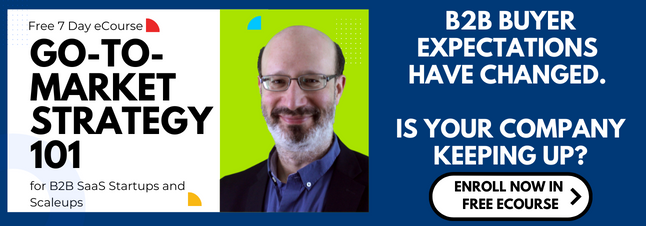In order for SaaS startups to grow and scale, founders need to recruit, hire, and retain the right people --the right team members. When it comes to drafting and signing the right team members, in the right roles, there’s a lot that SaaS startup founders can learn from professional baseball.
In this video, you’ll learn why SaaS startups need to think about recruiting and retention like baseball general managers (GMs), how to allocate go-to-market team members throughout the entire buyer’s journey, and what staffing for the full buyer’s journey looks like.
If you follow Major League Baseball (MLB), you’re likely familiar with the concept of innings that divide a game into segments, almost like chapters. A typical MLB game is nine innings and runs about three hours.
If you’re looking to build and grow a SaaS startup, your ideal customers have their own “game” they’re playing when they research and make purchase decisions.
From the perspective of customers, customers advance through a buyer’s journey -- the active research process in between when someone first identifies a problem they’re trying to solve, a goal they’re trying to achieve, or a question they’re trying to answer -- and when that person actually makes a purchase decision.

The buyer’s journey has three stages: awareness, consideration, and decision.
And SaaS startups need to adapt to recent and quite dramatic changes in how their ideal customers navigate the buyer’s journey.
The latest research from Gartner found that 83% of a typical B2B purchase decision -- researching, comparing options, and evaluating pricing -- happens before a potential buyer engages with a vendor.
And McKinsey & Company has discovered that 70% to 80% of B2B decision-makers now prefer to make decisions digitally.
In its B2B Thought Leadership Impact Report, LinkedIn, in partnership with Edelman, concluded that “thought leadership remains critical to customer engagement but breaking through the noise is harder than ever.”
So back to the back premise of this video --
Let’s explore further what specifically SaaS startups can learn from baseball.
Baseball players are incredibly specialized in an era where every decision is guided by analytics, known as sabermetrics.
At the most basic level, players typically get signed for either
- Early innings (innings 1 through 7)
- Late innings (innings 8 through 9)
In the early innings, baseball teams will draft or contract with
- Starting position players (catchers, infielders, and outfielders)
- Starting pitchers

For the late innings, baseball teams will draft or contract with
- Reserve or bench position players (catchers, infielders, and outfielders)
- Relief pitchers (said to pitch out of the bullpen, the warmup area)
And yes, some magically talented players can bounce all over the field and play all kinds of innings situations. And each baseball season, teams experiment with different player roles.
Yet when most teams develop player talent through the draft in their minor league system, or sign or trade established talent, the team’s front office leadership typically has a specific role in mind for that player.
And the team must have enough versatility, as many baseball games are won or lost in the ninth inning. Many are won or lost in the first inning. And some are even decided based on a string of lucky hits or events occurring in the middle innings.
Most SaaS startups don’t think like this but may benefit greatly from this analogy or way of thinking.
When most SaaS startups construct their team “roster” for marketing, sales, customer success, and product, nearly all investment goes to “players” for the late innings.

From a practical standpoint, this hiring decision means that the company isn't realistically resourced to compete in the first 60% to 80% of the buyer's journey when most self-directed buyer research and purchase preferences are formed.
imagine what would happen if...
- Professional baseball teams invested 90% of their team payroll in players only needed in the 7th, 8th, and 9th innings
- and only had 10% of payroll available for players needed for the 1st, 2nd, 3rd, 4th, 5th, and 6th innings
The key point here:
Poorly constructed rosters set your go-to-market team up to fail (across marketing, sales, customer success, and product).

The bottom line:
SaaS startup founders can learn a lot from professional baseball general managers (GM's) about how to responsibly construct their teams to compete in the digital buyer's journey.

And if you’re serious about What SaaS Startups Can Learn from Baseball...
Learn more when you enroll now in our free 7-day eCourse: Go-to-Market Strategy 101 for B2B SaaS Startups and Scaleups.



Submit a comment